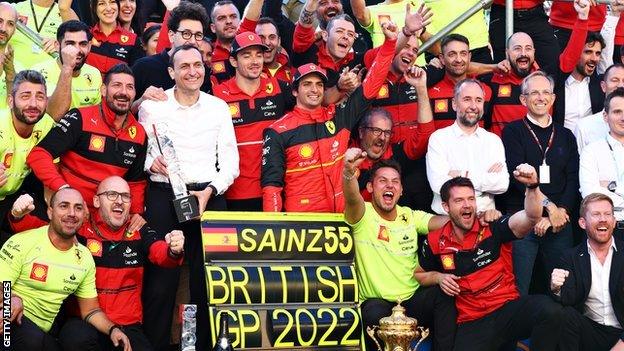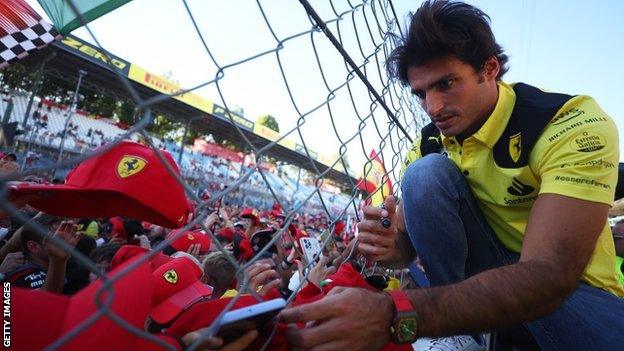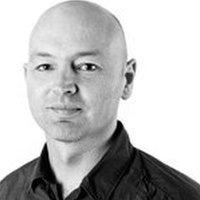Carlos Sainz: Ferrari driver 'had to reinvent myself' to challenge Charles Leclerc
- Published

Ferrari have had an up-and-down season, but Carlos Sainz says they have "stayed united"
Carlos Sainz is talking about reinvention; about reconfiguring his entire approach to driving to try to get on terms with his Ferrari team-mate Charles Leclerc this year.
The 28-year-old Spaniard has had a breakthrough season - taking his first pole position and his first win - but the big concern for this thoughtful perfectionist has been that for a long time in 2022 he struggled to meet his own high standards.
"It has been an extremely challenging season for me," Sainz says. "I found a lot of setbacks at the beginning of the year with this new car, with the new regulations, that didn't adapt to my driving style.
"I had to reinvent myself in many ways to try and find the pace.
"I didn't give up. I kept pushing even in the difficult moments, and you can see it paying off now at the end of the season in terms of speed."
Those few lines are Sainz in a nutshell - honest, self-critical, humble, determined, hard-working.
It can sound esoteric when a Formula 1 driver talks in this way - of driving style, of struggling with his car. But these things really matter.
Look at Red Bull, where the car was heavy and somewhat ponderous at the beginning of the year. Max Verstappen was unable to exploit his extravagant skills to the point that - early in the season - he was barely quicker than team-mate Sergio Perez. A bit of weight was taken out, and the car came alive for the Dutchman, who suddenly became effectively unbeatable.
Or at McLaren, where Daniel Ricciardo's struggles with the corner-entry characteristics of the car left him so far adrift of Lando Norris the team terminated his contract a year early. A winner of eight grands prix, all but one taken in swashbuckling style with Red Bull, finds himself without a seat on the grid next year.
At Ferrari, Sainz's struggles manifested themselves in Leclerc's overwhelming superiority in the first part of the season. The car has an oversteer balance - where the rear is loose and tends to move and slide - which Leclerc loved but Sainz could not handle as well.
Leclerc out-qualified Sainz in the first eight races in a row, at an average advantage of 0.265 seconds, as the older man struggled with the characteristics of the car.
"I have never been 0.2-0.3secs off any team-mate in F1 and I can never accept that," says Sainz, who was actually marginally faster than Verstappen in qualifying when they were team-mates at Toro Rosso at the beginning of their careers, and neck-and-neck with Norris at McLaren in 2019-20.
"I always feel like I am quick in any kind of car, and for the first time in my career I found myself with a very competitive car but one I didn't feel comfortable and natural with.
"I had to challenge myself and open up new roads of set-up and driving style that I wish I didn't have to open, because I wish everything had come a lot more natural and positively.
"But it happened this way, and I stayed disciplined. I tried a lot of things and I made a lot of mistakes trying things. But it was all about trial and error and then coming back and discovering a new path that was a little step forward."
A breakthrough and success
Gradually, things began to come together for Sainz. He fought for victory with Verstappen in Canada, just losing out, in a race Leclerc started from the back with an engine-related grid penalty.
Then, at the British Grand Prix, came that first pole, won superbly in the wet, with Leclerc third behind Verstappen.
The maiden win also happened that weekend, albeit only after Ferrari had scuppered Leclerc's chances with a strategy error.
And gradually the qualifying battle has shifted. After Silverstone, Sainz out-qualified Leclerc in Hungary, Belgium, the USA and at the last race in Mexico, where Leclerc complained of engine problems. In that period, the average gap between them has been only 0.013secs - still in Leclerc's favour, but so small as to be almost insignificant.
Against a man some regard as perhaps the fastest in F1 over one lap, it is some achievement.
"I'm realistic," Sainz says, "and I know how good Charles is in those conditions. This year he has been driving at a level that is very close to Max or any other driver. And for me he's in a way done a perfect season, apart from the two or three typical mistakes everyone does in a year, or the luck which maybe he has been lacking the same as me.
"I am not proud, because I am not ahead. The day I am ahead in the statistics is the day I will be proud. Until then, I will keep working at it, keep finding lap time in myself.
"But it's a statistic that makes me proud about the progress - not giving up, not letting myself get comfortable with being 0.2secs behind, and always challenging myself to find new ways of driving cars, which is not easy.
"When you see other drivers on the grid, you can see it is difficult to turn around a season, or turn around the feeling with the car. You don't see it very often. The fact I managed to do that makes me happy."

While Verstappen has won the title for the second successive year, Sainz is sixth in the standings
'A lot of people don't perceive my speed'
Sainz says he does not like talking about his strengths as a driver because, when he does, he reads interviews back and regrets it.
"Every time I do an interview and say my positives and I read them, I say: 'Ah, this sounds super-arrogant.' Maybe I go more towards the humble too much and stay in that way - modest. But whenever I see something a bit arrogant, I kill myself for it.
"So I always like to let you guys give your opinion of what you see as my strengths, while I criticise my weaknesses."
Nevertheless, like all F1 drivers, he spends a lot of time analysing his qualities - good and bad.
When told the qualifying statistics, he said he knew them already.
"Of course I know," he says. But he wouldn't bring it up in an interview unless explicitly asked. He accepts that may not always be to his benefit.
"A lot of people... sometimes they don't perceive my speed," Sainz says. "And I know how fast I am; I just don't like talking about it. I don't give it value, because if I know in myself and my engineers and the people I work with know it, I don't need more people to know it.
"Maybe I am not doing myself any favours, but it is how I am and I am not going to change."
'The race execution has been a weaker point'
For all the inner confidence, he recognises, too, that he still has plenty to work on.
Sainz beat Leclerc in Mexico, but the strong trend this year is that Leclerc has been the faster Ferrari driver in races, even in the second half of the season, after Sainz made his progress in qualifying.
Sainz is happy to admit that is an area in which he needs to progress.
"The race execution this year has been a weaker point of mine compared to the past," he says. "This year, we are struggling a lot with tyre management on these new Pirelli tyres.
"The starts with this car, for some reason, have been extremely difficult and we have an inherent problem that doesn't allow us to get off the line as well as in previous years.
"With these tyres, I don't control as well the tyre degradation and the race pace, and it's more difficult to be flexible, and it doesn't open up as many strategy choices as I would like to have or as I had in the past with McLaren.
"These are points I am going to work on in the final races and into next season to be more complete.
"But as you said, the qualifying gap has closed down a lot. I know I'm up against one of the fastest qualifiers - if not the fastest qualifier - on the grid, and so to be so close, it makes me proud to know there has been a lot of effort put into it but also that it's paying off."
'I am relatively cold-blooded'
One aspect of race management, though, has certainly been a Sainz strength this year. In a season in which Ferrari's strategy has been exposed - they have made a series of errors that have cost Leclerc big points - Sainz has been a shining light.
On a number of occasions, he has appeared to be running strategy from the cockpit, contradicting his engineers, and forcing them into changing their choices.
One key example was in Monaco, when he rejected their decision to come in for intermediate tyres as the track dried - something that wrecked Leclerc's chances of victory - and instead insisted on staying out, and changing straight to slicks.
It secured him second place between the Red Bulls, while Leclerc following instructions and changing to inters started a series of events that dropped him from the lead to fourth.
Likewise, at Silverstone, after a safety-car period in which Ferrari's decision not to pit Leclerc for fresh tyres led to him dropping from the lead to fourth, Sainz refused - as politely as he could - an order to back up and create a gap to his team-mate to protect him from those behind, on the grounds that doing so would compromise both their races.
This eased his path to victory, as he passed Leclerc, who then fought valiantly on his old tyres to delay Perez and Lewis Hamilton's Mercedes.
Sainz says the ability to read the race from the car is both natural and something he actively tries to develop.
"I am relatively cold-blooded in many aspects of life," he says. "Sometimes maybe too much. And I don't show maybe my tension, passion. But it is also something I work on.
"Having a good fitness level always allows you to have more brain space when you are driving. Having good confidence with the car and yourself helps you to have more brain space to think about what's going on in the race.
"And I feel like I always have a clear mind when racing and I can identify the opportunities and the chances to know what is right or wrong from the inside of the cockpit that sometimes is the biggest challenge.
"I know it's one of my strengths and I try to exploit it whenever I have a chance."

Sainz says Ferrari want to take "another step" next season
'A year of realisation' for Ferrari
For Ferrari as a whole, the season has been a rollercoaster.
There is considerable satisfaction that they finally managed to return to competitiveness, and that Leclerc was able to go toe-to-toe with Verstappen for the championship for a while.
The car's outright speed is evident from the fact no-one will be able to match Leclerc's score of nine pole positions, regardless of what happens in the final two races in Brazil and Abu Dhabi.
But there is also an acknowledgement that mistakes and reliability problems torpedoed their chances, questions as to why the car is rarely as effective in races as in qualifying, and concern they have fallen behind in the development race, just as they did the last time they had a competitive car in 2017 and 2018.
"There are definitely some mixed feelings in the team," Sainz says. "We are super-proud of the progress we have done with the car to get back to where we are. But this has also been a year of realisation that there are still areas to work on and improve.
"We are being super-disciplined and super-coherent and ultra-critical behind closed doors as to which areas we need to improve to match our competitors in certain areas, or be better than them, which has to be the target.
"The team is taking note of everything and we are going to try and take another step next year. Will it be enough? I don't know. But it's definitely a target."
In the past, a year such as this might have led to heads rolling at Ferrari. But Sainz says team principal Mattia Binotto has stuck to the no-blame culture he is determined to engender, after its success at Mercedes and Red Bull.
"It's incredibly difficult to execute and especially in a team like Ferrari, where there is so much pressure and so much attention on us, and everyone wants changes immediately as soon as something is wrong," Sainz says.
"Mattia has done an excellent job at not losing the cool head at any point. We have had a lot of difficult moments, a lot of criticism, and he has remained stuck to his principles.
"No-one has been fired. We stayed united in the most difficult moments and it shows the progress of our culture.
"It is always exposed to criticism and high attention on all our mistakes. When we win, it's incredible - it is the best win in the world to win for Ferrari.
"To go through such a difficult season as we did with so few problems in the team is something to be valued."

Do longer prison sentences reduce crime? Bad People goes in search of answers
The champion of two courts ignored by the world: Ora Washington fought to make her name in racially segregated America

